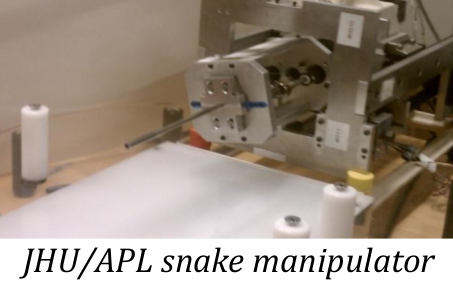Table of Contents
Interfacing APL Snake End Effector to LARS Robot
Last updated: 12th May 2013
Summary
Enter a short narrative description here
- Students: Piyush Routray, Ashish Kumar
- Mentor(s): Ryan Murphy, Mike Kutzer, Mehran Armand
The following pictures depict the 'snake' as it is from previous work(s).
Background and Significance
The main and static aim of our project is to interface the APL Snake end effector to the LARS. The APL Snake is a surgical manipulator intended to be used in hip osteolysis removal surgery. However, since development its potential has been realized and it is being constantly upgraded to be a self sustained surgical tool. Initially, it was controlled through mouse and keyboard only. Intuitive control interface for the manipulator, has since, been designed and integrated with the snake using PHANTOM® Premium haptic controller. The desire to further reduce human intervention for its operation and make the setup fully automated, still remains. The Laparoscopic - Assisted Robot System (LARS) is an ideal platform for achieving the same due to its mobility, dexterity, and versatility of use with various end-effectors. End point control of the Snake is to be achieved following the inverse kinematics of LARS with the manipulator. The demonstration of the level of achievement of the same is planned to be shown on cardboard, solid model(s) after registration and finally on cadavers; chronologically.
Deliverables
- Minimum: (Expected by ?)
- Fix the LARS—————————————————→(-)
- End-point control———————————————→(Apr 20th)
- Expected:
- 3D Registration and alignment with insertion axis– →(Apr 29th)
- Maximum:
- Configure the Snake in any desirable alignment—- →(May 6th)
- Demonstration of the same on cadaver————— → (*)
*after the end of EN.600.446 timeline Prof. Armand expects us to demonstrate application on a cadaver and record video of the same.
Technical Approach
- Understanding ‘Galil Suite’ and DMX Controller of the LARS.
- Develop understanding of CISST Library .
- Repair the LARS and get it up and working.
- Calculate the inverse kinematics equations of the LARS.
- Simulate the above on MATLAB.
- Implement end-point control using a dummy snake.
- Achieve 3D registration and alignment with the insertion axis.
- Come up to terms with Snake Robot control software.
- Configure snake in desirable positions.
Dependencies
• Requirement of parts/tools for replacement in the LARS. Since the repairing of the previous LARS was taking more time than expected we , after discussion with out mentors and Dr Taylor, switched to new LARS robot which we received on 10th April 2013.
• Working platform/software with the snake. We hope to have a working platform/software which can control the snake’s precision. This will allow us to implement accurate control of snake after mounting it on the LARS.
Milestones and Status
- Getting the LARS completely ready
- Planned Date: 15th Mar 2013
- Expected Date: 31st Mar 2013
- Status: Since the repairing of the previous LARS was taking more time than expected we , after discussion with out mentors and Dr Taylor, switched to new LARS robot which we received on 10th April 2013.
- Algorithms for Pre-operative procedures like registration.
- Planned Date: 25th Mar 2013
- Expected Date: 25th Mar 2013
- Status: Done on 15th April 2013
- Forward & Inverse Kinematics Modelling of the LARS on MATLAB.
- Planned Date: 31st Mar 2013
- Expected Date: 15th April 2013
- Status: Forward Kinematics of the LARS modelling in MATLAB is done.
- Integration of Controllers of LARS & Snake
- Planned Date: 8th April 2013
- Expected Date: 22nd April 2013
- Status: Further work will begin on this after completion of previous milestones.
- Achieving end point control with the Snake on LARS.
- Planned Date: 15th April 2013
- Expected Date: 29th April 2013
- Status: Partially Done.
Reports and presentations
- Project Plan
- Project Background Reading
- See Bibliography below for links.
- Project Checkpoint
- Project Final Presentation
- Project Final Report
Project Bibliography
[1] M. D. M. Kutzer, S. M. Segreti, C. Y. Brown, R. H. Taylor, S. C.Mears, and M. Armand, “Design of a new cable-driven manipulator with a large open lumen: Preliminary applications in the minimallyinvasive removal of osteolysis,” in Robotics and Automation, 2011. ICRA 2011. Proceedings of the 2011 IEEE International Conference on, 2011.CableDrivenManipulator
[2] J. Funda, R. Taylor, B. Eldridge, S. Gomory, and K. Gruben, “Constrained Cartesian motion control for teleoperated surgical robots,” IEEE Transactions on Robotics and Automation, vol. 12, pp. 453-466, 1996.
[3] Galil Motion Control, Inc. DCM-40×0 User Manual, Rev. 1.0c. Dec, 2008. www.galilmc.com
[4] Galil Motion Control, Inc. DCM-40×0 Command Reference, Rev. 1.0d. Dec, 2008. www.galilmc.com
[5] G. Hamlin and A. Sanderson, A Novel Concentric Multilink Spherical Joint with Parallel Robotics Applications. IEEE, pp. 1267-1272. 1994.
[6] A. Kapoor, M. Li, and R. Taylor, Constrained Control for Surgical Assistant Robots. IEEE Int’l Conf. on Robotics and Automation. pp. 231-236. May 2006.
[7] A. Kapoor. Motion Constrained Control of Robots for Dexterous Surgical Tasks. Johns Hopkins University Ph.D. Thesis. Sept, 2007.
[8] P. Marayong, et. al. Spatial Motion Constraints: Theory and Demonstrations for Robot Guidance Using Virtual Fixtures. IEEE Int’l Conf. on Robotics & Automation. pp. 1954-1959. Sept. 14-19, 2003.
[9] R. Taylor, et. al. A Telerobotic Assistant for Laparoscopic Surgery. IEEE Engineering in Medicine and Biology. pp. 279-288. May/June 1995
Other Resources and Project Files
Please check the Project Report for other references.


